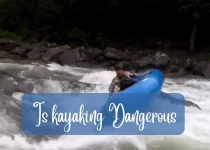How to Roll a Kayak (Best Guide in 2023)?
Kayaking is an exciting outdoor activity that all ages can enjoy. However, even the most experienced kayakers may find themselves capsized at some point.
Then the skill of kayak Roll falls into the hands of every kayaker. Rolling a kayak is the process of righting a capsized kayak without having to exit. It may seem like a counterintuitive skill to learn, but with practice, the kayak roll technique involves a combination of body movement and paddle support in the water.
There are various methods for rolling a kayak, and each requires a different level of skill and technique. Learning how to roll a kayak with perfection can be challenging, but it can also be extremely rewarding. In this article or piece of writing, we will discuss the basics of rolling a kayak and provide different tips and methods on how to improve your technique.
Why is it important for every kayaker to learn to roll a kayak?
Every kayak lover must have the skill to roll a kayak because I may help you boost your confidence and stay calm in the worst conditions.
Proper paddling technique is also important, but safety rolling is a skill that every kayaker should master. Kayaks sit-on does not have a cockpit, so if you flip the boat, you will fall off the kayak. But sit-in kayaks have a cockpit that keeps you strapped in and helps you stay gripped by the kayak.
While knowing how to do a wet exit is helpful, it may not always be the best solution.
This is where a reliable roll comes in as a preferred maneuver. Moreover, a roll boosts your confidence, especially in situations where you need to stay inside the kayak.
How do beginners learn how long it takes to roll a kayak?
Here we list down some points that will help you learn to roll a kayak for beginners. These points are full of knowledge for kayak safety for beginners.
- First, it is best to practice rolling a kayak in calm, clear, and warm waters, such as a swimming pool, where there are no obstacles, strong currents, or any other obstacles to worry about.
- Then you practiced a lot further, which may also improve your skills and gradually increase the difficulty of the water conditions as well.
- It is also recommended that you perform at least 150 successful kayak rolls in calm, flat water or a swimming pool before attempting dynamic or worst-case scenarios.
- For a beginner, it is crucial to have someone expert with you as you are trying to master the kayak, and an experienced instructor can make a significant improvement to your kayak roll.
- The best way to learn how to roll a kayak is the most challenging skill, which requires different forms of physical skills, learning styles, and body awareness levels.
- Generally, two or three 90-minute sessions with a good instructor should be enough to grasp the dynamics and hit your first unassisted roll in your kayak.
- However, consistent practice over weeks or months is necessary to master the skill of rolling a kayak.
Types of Kayak Rolls
For any specific situation concerning safety, there are different methods used to roll a kayak. Also, not all kayak types are the same for all conditions and environments. Here we list some kayak roll methods and describe a guide to rolling kayaks. Check out and read the most commonly used methods for kayak rolls.
1. Screw Roll (Sweep Roll) and How to Do a Sweep Roll
The sweep roll, also known as the screw roll, is one of the most commonly used safety rolls by experienced kayakers. This type of kayak roll requires a musty sweeping of your paddle from the bow towards the stern across the water.
As compared to the C-to-C roll, the sweep and screw roll is slightly more challenging to learn, but it offers more support from your paddle. It is an ideal method to roll in open and flat water where you have more space to perform the hip snap technique that brings you back to an upright position.
Furthermore, this type of roll requires more space than the C-to-C roll, which may not be suitable for narrow spaces.
Overall, a true suggestion: Sweep roll is a much more reliable and effective technique for kayakers who want to protect themselves while on the worst water. One point is that learning to roll a kayak takes good practice, patience, and an experienced instructor.
Through regular practice, exercise, and determination, you can master kayak rolling and gain much confidence while kayaking in different types of water conditions. This is the best kayak roll technique for beginners
Pros
- Through paddles, may protect and support you throughout the activity.
- Less setup and easy and simple to roll a kayak
- 100% safe, and keep it protected.
- The practice may be performed easily in flat and open water conditions.
Cons
- It may require more space on the water.
- More difficult as compared to the C-to-C roll.
Guide On How to Roll a Kayak Through Screw Method (Step By Step
Here is a kayak guide and the main point on how to roll a kayak through the screw method.
- The sweep or screw roll is a fundamental kayak rolling technique and a good place to start for beginners.
- To perform a sweep roll perfectly, you have to swing the front blade of your paddle away from your kayak and form an arch into the water.
- While the blade is moving through the water, keep the head submerged, and then watch your blade.
- In the fourth step, apply downward pressure on the blade so that it moves much closer to a 90-degree angle.
- Once you have felt the paddle blade on perfectly at a 90-degree angle and also feel support from it, you have to snap the kayak back into the upright direction up through your hips.
- Finally, roll up and out of the water along with the kayak’s back deck.
2-C to C Roll
The C-to-C roll is the most popular safety roll among whitewater kayakers due to its fast execution and deep stability method. It is easy to learn and consistent, making it a reliable choice for those who are just starting to learn how to roll a kayak.
The C-to-C roll method requires the best initial setup to start. It involves placing your paddle at a 90-degree angle to your cockpit and forcing the blade down while using your hips to the right of the boat. Although the paddle’s blade goes deeper into the water while performing the C-to-C roll, that provides more stability and is less likely to slip out of your hands. This makes it a good choice for rough or open water.
Overall, the C-to-C roll is a reliable and fast roll that can be learned quickly and is useful for paddling in whitewater.
Pros
- Through this technique, you learned that it easily features deep stability and fast execution.
- It is almost suitable for narrow spaces like swimming pools.
Cons
- The disadvantage is that the paddle’s blade may go deeper into the water, a danger for people of lower heights.
Guide On How to Roll a Kayak Through C to C Method (Step By Step
Here are some points and a guide on how to do a C-to-C.
- Whitewater kayakers usually prefer a C-to-C kayak because it is more reliable in rough conditions.
- In the second step, you have to start with your paddle at a 90-degree angle to the kayak before applying downward pressure.
- Swing your paddle’s front blade along with the surface of the water because it is perfectly positioned at 90 degrees to the kayak’s hull.
- Always keep the blade close to the surface of the water.
- Then watch the paddle that is moving around the water.
- Press your left forearm against the kayak’s side as a pivot point.
- Start applying downward pressure until you can feel the support from the paddle blade.
- Through your hips, snap the kayak back into an upright position when you feel the support of the kayak.
- Then get yourself out of the water along the kayak’s back deck position.
3-Reverse Sweep (Back Deck Roll)
The reverse sweep roll, also known as the back deck roll or reverse screw roll, is a recovery method used for leaning back against your kayak from the water. This method uses a standard screw that is rolled backward and is relatively easy to perform, even when you see it in an unideal position.
It minimizes the time spent upside down and does not require you to position yourself for a proper safety roll. It is similar to a sweep roll, but instead of sweeping the paddle from bow to stern, you will sweep it from stern to bow and back again.
One potential downside to the reverse sweep roll is that it can be much more challenging to maintain a connection with the kayak.
However, it is also a useful technique to know and can come in handy in certain situations, especially for those who are less experienced or have difficulty with the traditional safety role.
Some Principles of Rolling Kayak
Here is what we explain below:
1-Choose a safe and calm location
When it comes to learning how to Eskimo roll for the first time, it is best to do it in a calm and controlled environment. Ideally, you want to avoid obstacles, waves, or currents that could make things more difficult.
For this reason, a swimming pool can be a great place to practice. Pools offer a stable and predictable environment where you can focus solely on perfecting your technique without any outside distractions or dangers.
Additionally, a pool allows you to easily observe your technique and make adjustments as needed, as the water is clear and still.
Overall, starting in a swimming pool can give you the confidence and skills you need to eventually tackle more challenging waters.
2-Preparing yourself for the roll (how to prepare for the roll)
Learning to roll a kayak is an essential skill for any kayaker, and it all starts with getting the basics right.
Two of the most common rolling techniques are the sweep roll and the C-to-C roll, in which you can start from the same position. Starting from this position allows for an easier understanding of the basic mechanics involved in rolling a kayak.
However, in real-world situations, it may be necessary to make some adjustments to your body position to achieve a successful roll.
The setup stage of the kayak roll involves going from an upright position to an upside-down position, which is fully submerged with your paddling technique and body in the same position.
Once you are underwater, move your head toward the surface and as far out from your kayak as possible while keeping your forearms pressed against the kayak’s sides. The paddle should sit above the surface of the water.
Mistakes to avoid while kayaking Rolls (Top Tips and Suggestions)
Sure! Here are some of the top tips and good suggestions that will help you avoid common mistakes while kayak rolling:
- Body Positioning: – Maintain a balanced and centered position in the kayak before initiating the roll. Keep your head low and close to the deck of the kayak to minimize water resistance.
- Paddle Placement: – Ensure your paddle blade is perpendicular to the water’s surface when starting the roll. Avoid placing the paddle too far forward or backward, as it can affect your leverage and balance.
- Hip Snap:- Perform a powerful hip snap by driving your hips and upper body in the opposite direction of the roll. Focus on generating explosive force with your hips to help bring the kayak upright.
- Timing and Patience: – Avoid rushing the roll. Take your time to set up and execute each step with precision. Don’t panic if the roll doesn’t succeed on the first attempt. Remain calm and maintain your focus.
- Head and Eye Placement:- Keep your head aligned with the kayak’s centerline during the roll.
- Hand Positioning: – Maintain a firm grip on the paddle, but avoid gripping it too tightly. Ensure your hands are positioned correctly on the paddle shaft for optimal control and power.
- Practicing in Calm Conditions: – Start practicing rolling techniques in calm and controlled waters before attempting more challenging conditions. Mastering the role in controlled environments will build your confidence and improve your technique.
- Seek: – Consider taking a kayaking course or receiving instruction from an experienced paddler or certified instructor. Professional guidance can help identify and correct any mistakes specific to your technique.
- Physical Conditioning: – Strengthen your core muscles and work on flexibility to improve your rolling abilities. Engage in exercises that target your abdominal, back, and hip muscles to enhance stability and control.
- Regular Practice: – Consistency is key. Practice your rolling technique regularly to maintain and improve your skills. Set aside dedicated practice sessions to reinforce muscle memory and build confidence in your role. If you find yourself in challenging or unfamiliar conditions, it’s best to prioritize self-rescue techniques and seek assistance when needed.
Conclusion
Learning how to roll a kayak can be a vital skill for any kayaker, especially when paddling in rough waters or whitewater. However, it’s essential to practice in a safe environment and have someone around who can assist if needed.
Nevertheless, with practice, the process of rolling can become second nature, providing kayakers with the confidence they need to tackle challenging situations. Remembering the fundamental principles of rolling and the steps until they become an instinctual response can make all the difference between panicking and confidently continuing your kayaking adventure.
FAQs
Which type of kayak is much more stable?
In general, wider and shorter kayaks tend to be more stable than longer and narrower kayaks. So, a recreational or fishing kayak with a wider hull is typically more stable than a sleeker, touring, or sea kayak. However, stability can vary depending on the specific design and features of the kayak, so it’s always a good idea to try out different models and consult expert recommendations before making a decision.
Can you sit on your knees in a stable kayak?
No, in most kayaks, you do not sit on your knees. This is true for both sit-on-top kayaks and sit-inside kayaks. However, there are certain specialized kayaks, such as whitewater kayaks or some surf kayaks, where kneeling or using a specific kneeling position with your knees bent is required for better control and balance in rough water conditions.


